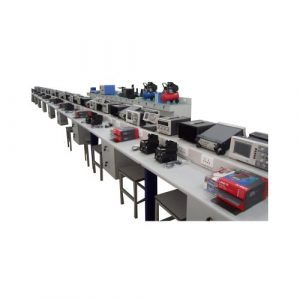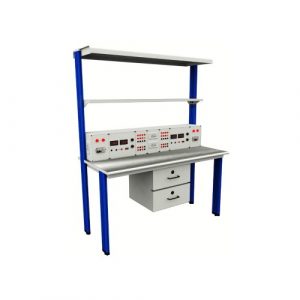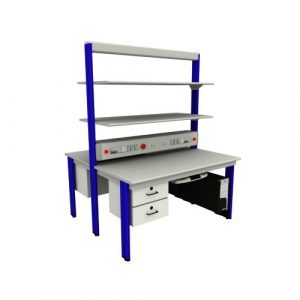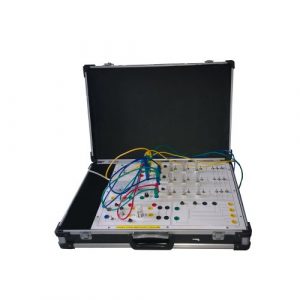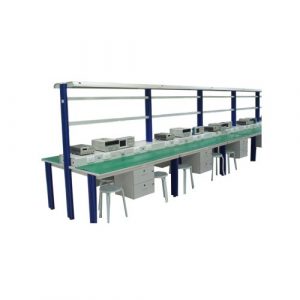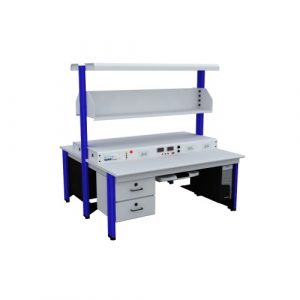- Description
- Inquiry
TB230621S45 PIC Innovative Experiment Development Kit Didactic Equipment Electrical Laboratory Equipment
1. Overview
Based on the Keil C single-chip microcomputer series, focus on the application of the functions of the single-chip microcomputer itself, and fully reflect the characteristics of the single-chip. The basic functional experimental circuit adopts an integrated design method, and the innovative and expanded experimental circuit adopts an independent module method. When necessary, it is connected to the main board, taking into account the demonstration verification. Sexual experiments, taking into account the needs of comprehensive design and innovative research experiments. The motherboard comes with a CPU programming download interface. It is a new single-chip microcomputer experimental teaching platform that integrates programming, downloading, and debugging with strong flexibility. It is suitable for students at all levels to conduct experiments and innovations in the principles and applications of single-chip microcomputers.
2. Main technical features
1. Support multiple CPU experimental development, including 51, MSP430, AVR, PIC, STM32 and other single-chip microcomputers. Each CPU module has a uniform size and interface, and shares an experimental base board. It supports Keil C and provides detailed experimental instructions. Standard 51 single-chip core system.
2. Functional modules are completely independent
According to our development experience over the years, and listen to the suggestions of the majority of users, this development board adopts the latest concept – each
The functional modules are completely independent and do not interfere with each other, reducing programming misunderstandings for beginners. The board is rich in experimental hardware resources and interfaces, and all I/O ports are open to the outside world. You can simply use the short-circuit cap for default resource connection (convenient for beginners to use directly), or take off the short-circuit cap and use Dupont wires to connect Any I/O port line of the microcontroller, easy to build your own circuit.
3. Cooperating with a large number of experimental routines carefully prepared by our company, users can quickly grasp the principle of single-chip microcomputer and its practical interface technology. At the same time, it can strengthen beginners’ understanding of the hardware circuit of the motherboard, and get familiar with the hardware circuit as soon as possible. Because each functional module is designed independently, various single-chip microcomputers can be directly used without the need for a second investment.
4. All the hardware in the detailed hardware configuration below are integrated on a main board, which is stable and reliable, easy to operate, and also convenient for laboratory management.
3. Detailed hardware configuration
(All the following hardware is integrated on one main board, no external expansion is required, and all the following experimental items are completed, which is convenient for laboratory management)
3.1 Basic circuit module
3.1.1 Monochromatic water light module: 8 bright green LED lights, used for water light experiments.
3.1.2 Two-color running water light module: 6 high-brightness in-line LED lights, three colors of red, yellow and green, used for traffic light experiments.
3.1.3 Two-color LED light module: red and green two-color in-line LED light, used for simple logic pen design.
3.1.4 8-bit digital tube module: 2 four-in-one common anode digital tubes, 2 74HC595 driver chips, used for clock display experiments.
3.1.5 1-digit digital tube module: one 8-segment digital tube, common anode, 0.56 inches, used for the digital tube recognition experiment.
3.1.6 Red and green dot matrix module: three 74HC595 driver chips, one red and green dot matrix display, LED display for characters and Chinese.
3.1.7 LCD1602 liquid crystal screen module: standard LCD1602 liquid crystal screen interface, one LCD1602 liquid crystal screen with backlight, used for character liquid crystal display experiment.
3.1.8 LCD12864 LCD module: Standard LCD12864 LCD interface, supports serial and parallel LCD screens, used for image and Chinese display.
3.1.9 OLED display module: 0.96-inch OLED LCD screen, 128*64 display, used for application learning of new display OLED LCD screen.
3.1.10 TFT color screen module: The color screen interface supports 8-bit and 16-bit TFT, supports touch screen control, and has a backlight switch. Supporting 2.8-inch color screen with touch screen function, 262K colors, 8-bit data terminal.
3.1.11 8 independent buttons: 8 independent buttons with pull-up resistors.
3.1.12 4X4 matrix keyboard: matrix keyboard with 4 rows and 4 columns, 16 keys in total, with pull-up resistors.
3.1.13 Five-way joystick: a five-way joystick with five directions: up, down, left, right, and center.
3.1.14 Buzzer module: passive buzzer
3.1.15 DS1302 clock module: DS1302 chip, the module has a back battery holder.
3.2 Sensor Module
3.2.1 Two-way DS18B20 module: Two-way DS18B20 temperature sensor interface.
3.2.2 Photosensitive sensor module: integrated LM393 comparator, adjustable reference voltage resistor, analog output interface, digital output interface, analog indicator LED light, support photodiode, photoresistor and other photoelectric switching devices.
3.2.3 Flame sensor module: integrated LM393 comparator, adjustable reference voltage resistor, analog output interface, digital output interface, analog indicator LED lights, support flame sensor.
3.2.4 Hall sensor module: integrated LM393 comparator, adjustable reference voltage resistor, analog output interface, digital output interface, analog indicator LED lights, support Hall sensor.
3.2.5 It is possible to configure wireless transmitter modules, RFID sensors, etc. (arbitrarily configure various sensors according to user requirements).
3.3 Electrical control module
3.3.1 1 channel DC motor interface: ULN2003 driver chip. All the way adjustable speed, adjustable direction dual-function motor interface.
3.3.2 1 way stepper motor interface: ULN2003 driver chip. Standard 5-wire 4-phase stepper motor interface.
3.3.3 2-way relay: ULN2003 driver chip. Two 5V relays, two 3P terminals.
3.4 Data transmission and storage module
3.4.1 2-way serial port: SP3232 chip, +3.0v-+5V working voltage, one male serial port socket, one female serial port socket, and four status indicator lights.
3.4.2 AT24C02 storage module: AT24C02 chip.
3.4.3 Analog input module: 0V-5V input adjustable, 0R-10K resistance adjustable.
3.4.4 Serial-to-parallel module: 74HC164 chip.
3.4.5 Parallel-to-serial module: 74HC165 chip.
3.4.6 SD card module: standard SD card slot, SPI control, 4-bit transmission mode.
3.4.7 MAX485 module: MAX485 chip, 1 set of 2P terminal output, 1 set of pin output.
3.4.8 Infrared emission module: Infrared emission diode.
3.4.9 Infrared receiving module: HX838 infrared integrated receiving head.
3.4.10 PCF8591 AD/DA module: PCF8591 chip, 4 analog inputs, 1 analog output, IIC communication.
3.4.11 Latch module: 74HC573 latch chip, compatible with standard CMOS.
3.4.12 Three-eight decoder: 74LS138 chip, TTL level.
3.4.13 Core board expansion interface: two rows of interface sockets 20P, two rows of IO expansion pins 20P.
3.5 Power Module
3.5.1 3V3 power supply circuit: LM1117-3V3 regulator chip.
3.5.2 1V8 power supply module: LM1117-1V8 voltage regulator chip.
3.5.3 Power supply lead-out: GND/5V/3V3/1V8 power supply each group, each group has 6 leads.
3.5.4 Self-recovery fuse: disconnect current 300ma.
3.5.5 Module name: USB interface, mini USB, A-type female, D+, D-.
3.6 Standard 51CPU module
3.6.1 Equipped with one CPU chip STC12C5A60S2 series.
3.6.2 Comes with online download circuit.
3.7 Virtual Oscilloscope
3.7.1 A real high-speed dual-channel storage virtual oscilloscope, which can be switched to a single channel to increase the sampling rate.
3.7.2 With real-time X-Y oscilloscope: automatic synchronization display function.
3.7.3 Storage function: store/load/analyze historical waveforms.
3.7.4 The amplitude of the input analog voltage signal is adjusted by software, without hardware switch.
3.7.5 A dedicated virtual oscilloscope with amplitude-frequency/phase-frequency characteristics. Waveform files and image files can be saved for easy insertion into teaching courseware.
3.8 Chassis
3.8.1 Rugged aluminum alloy frame, thick ABS plastic corners, reference dimensions 460×380×120mm.
3.8.2 There is a spare parts storage area of 70mm×350mm.
3.9 Software
3.9.1 Integrate a variety of single-chip compatible general KEIL software environment, support assembly and C language programming, compilation, linking and source level debugging and online download.
3.9.2 Online download software: STC_ISP_V479.
3.9.3 MGCS industrial configuration software.
3.9.4 C language programming MCU application design routine.
3.9.5 Interface routine between MGCS industrial configuration software and single-chip microcomputer.
3.9.6 Support the simulation experiment matched with the hardware of the experiment box.
4. Experimental projects that can be realized
4.1 Basic experiment
1) Marquee lantern and running water lamp experiments
2) Experiments on colored running lights and traffic lights
3) Display in red and green colors.
4) Electronic clock display, digital tube multi-digit display, 74HC595 drive and other experiments.
5) 1 digit digital tube display experiment.
6) Two-color dot-matrix screen display experiment, scrolling, static display of characters, Chinese symbols, etc.
7) LCD1602 LCD display experiment, which can display characters, numbers, etc.
8) LCD12864 liquid crystal display experiment, which can display Chinese characters, characters and numbers
9) OLED display experiment, which can display 4 lines of Chinese characters and pictures.
10) TFT color screen image and text display. It can be used as a human-computer interaction interface.
11) Experiments such as button control and external interrupt.
12) Matrix keyboard experiment, which can be used for control, teaching experiment, etc.
13) Game joystick, realizing functions such as independent buttons.
14) Music playback, alarm prompts, etc.
15) Experiments on electronic watches and perpetual calendars.
4.2 Sensor experiment
1) Temperature measurement.
2) Photoelectric switch experiment.
3) Fire alarm, flame detection and other experiments.
4) Speed measurement, electromagnetic detection and other experiments.
4.3 Electric control experiment
1) Driving experiment of DC motor speed regulation and direction regulation.
2) Driving experiment of stepping motor speed regulation, direction regulation and angle regulation.
3) Relay control experiment.
4.4 Data transmission, storage module functions.
1) Serial communication, TTL to RS-232 experiment.
2) External storage, IIC bus learning.
3) Serial to parallel experiment, can expand IO.
4) Parallel data to serial experiment.
5) SD card reading and writing, file system learning experiments.
6) With multiple groups of 485 modules, 485 communication experiments can be carried out.
7) The experiment of transmitting infrared signals with different carrier frequencies.
8) Infrared receiver decoding experiment.
9) AD/DA conversion experiment.
10) 8-bit data latch experiment, can be used as driver and buffer module for CPU and peripheral modules.
11) IO expansion, learning decoding experiment.
4.5 Industrial configuration software MCGS programming experiment
4.6 Application experiment of industrial configuration software MCGS in single-chip microcomputer control
1) Stepping motor control experiment_bus control
2) DC motor control experiment_bus control
3) Industrial sequence control experiment_bit control
4) Data acquisition experiment_bus control
5) Data acquisition experiment_bus control
6) Digital voltmeter experiment
7) Liquid mixing control experiment
8) Traffic light control experiment
4.7 Interface programming experiment of industrial configuration software and microcontroller
5. Experiment box configuration table
| No. | Name | Instructions | Quantity |
| 1 | Multi-core microcontroller experiment box (standard configuration) | Including cabinet, power supply, 51CPU single-chip microcomputer core system, and experimental module circuit. | 1 set |
| 2 | DuPont cable | 8 cores 30cm | 4 pcs |
| 3 | DuPont cable | 5 cores 30cm | 3 pcs |
| 4 | Single Root DuPont | 40cm | 10 pcs |
| 5 | XH2.54 cable | 5 cores 12cm | 1 pcs |
| 6 | RS232 serial port communication line (2, 3 straight through) | 1.5m (download cable) | 1 pcs |
| 7 | AC power cord | 1.5m | 1 pcs |
| 8 | remote control | 1 pcs | |
| 9 | RS232 serial communication line (2, 3 crossover) | 1.5m(the oscilloscope communication cable required when configuring the oscilloscope module) | 1 pcs |
| 10 | supporting software | One piece of KEIL C software and configuration software | 1 set |
| 11 | Experiment Guide | 1 book | |
| 12 | PIC16 microcontroller core system (send) | 1. PIC16F887 core board 2. PIC16 downloader | 1 set |






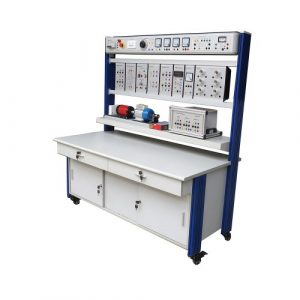
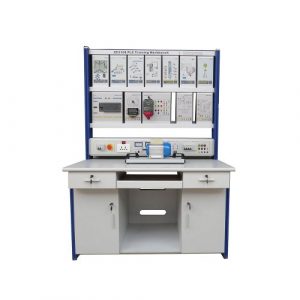
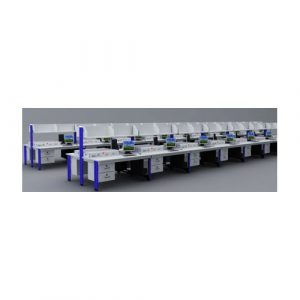
-300x300.jpg)
